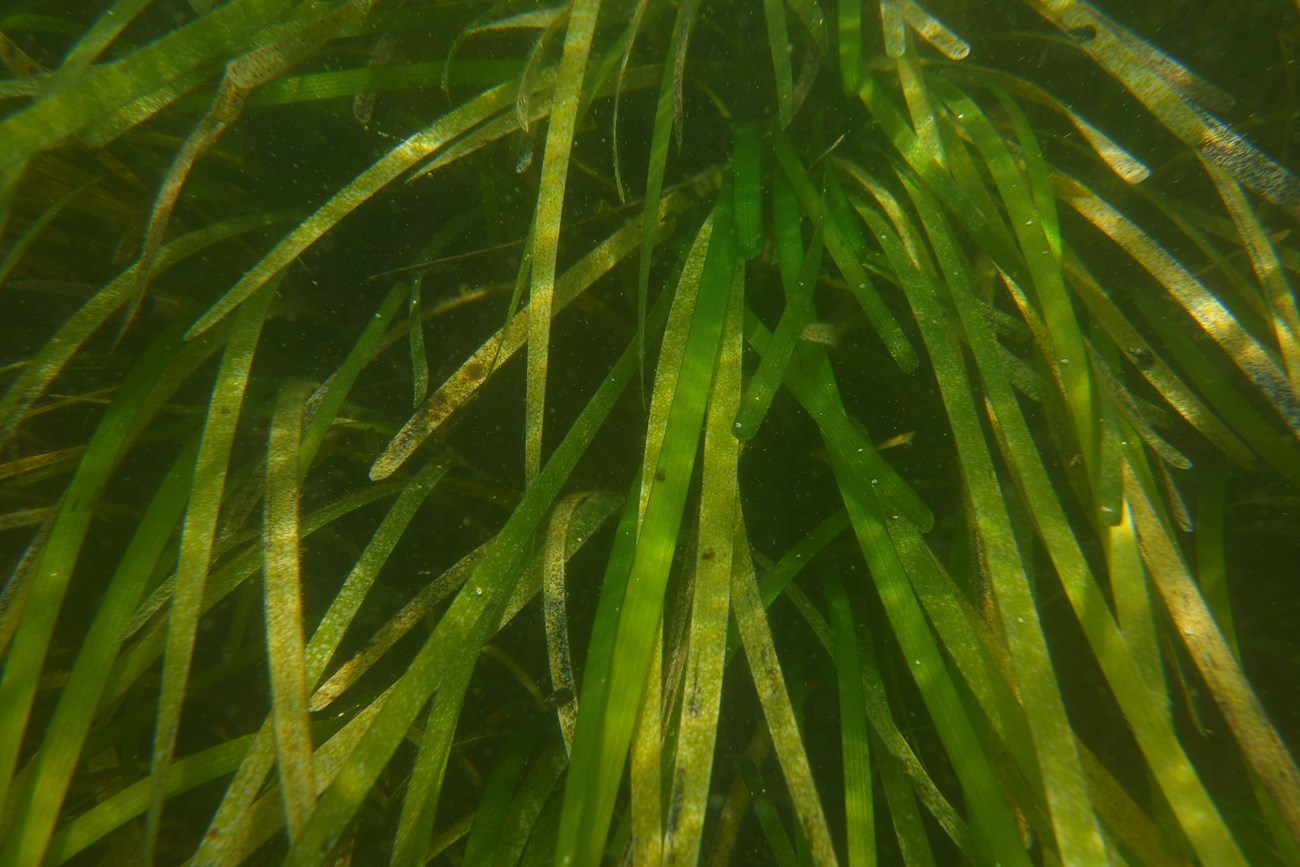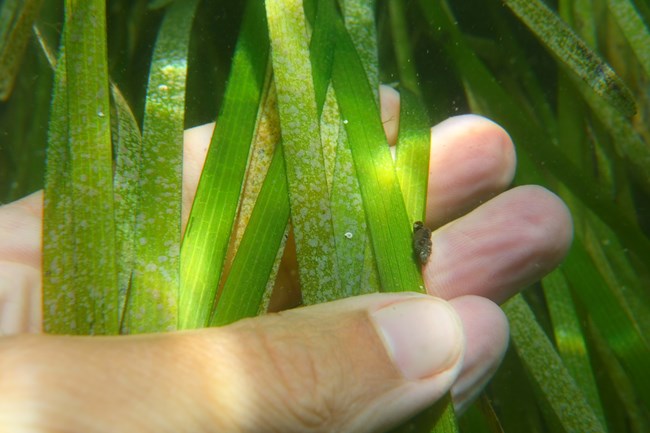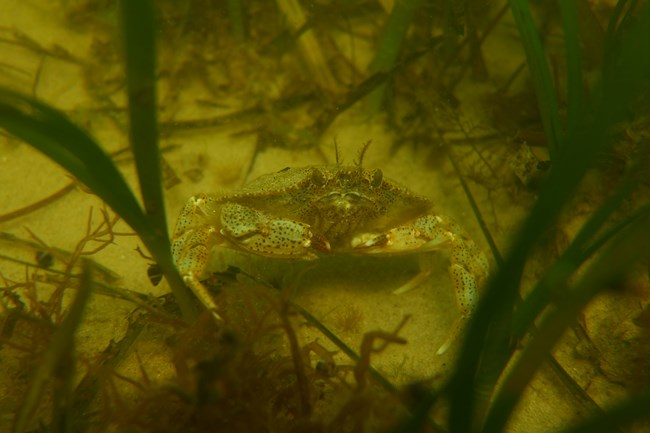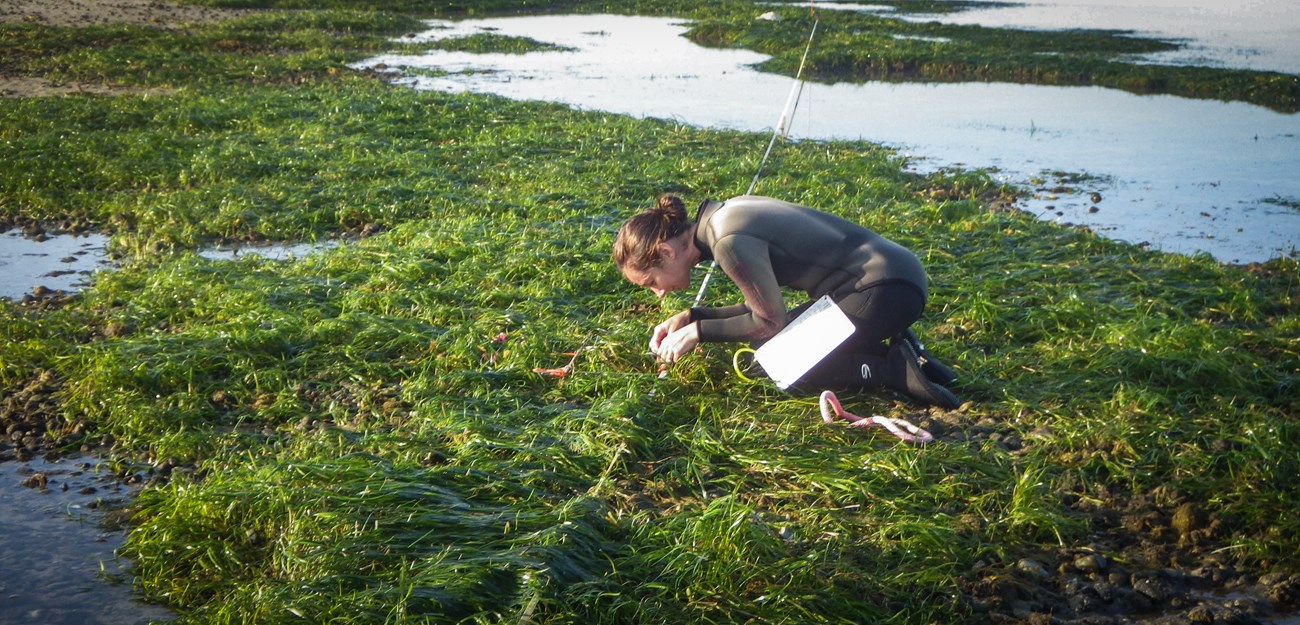Part of a series of articles titled Northeast Coastal and Barrier Network Species Spotlight.
Article
Northeast Coastal and Barrier Network Species Spotlight: Eelgrass

Holly Plaisted, NPS
A submerged city
As the rising sun glistens off the never-ending expanse of ocean, nothing may seem more serene. Just under the calm and beauty of this picture, lays a meadow of bright green leaves swaying along with the ebb and flow of the current. The leaves bask in the sunlight while simultaneously soaking up energy for photosynthesis and oxygenating the water column, supporting water quality. Anchoring these plants and stabilizing the sediment is a vast network of rhizomes and roots, hidden just inches beneath the sediment surface, but detectable by touch. Crustaceans and horseshoe crabs are found creeping around the bases of eelgrass (Zostera marina) foraging for invertebrates and other meals. Just above them, schools of juvenile fish find protection from strong waves and predators within the meadows of green. At the surface, water birds such as brant geese eat eelgrass leaves as their primary food source. From root to the swaying canopy above, eelgrass is vitally important to all facets of the coastal environment.
Think of large expanses of eelgrass as “submerged cities” where many creatures coexist. Eelgrass meadows across the Northeast provide a home and protection for a diverse community of wildlife. Small animals and invertebrates such as flounder, crabs, and bay scallops rely on eelgrass for protection. Large fish like the Atlantic cod come to estuaries and eelgrass beds to lay their eggs in safety. Tiny juvenile oysters and scallops also cling to eelgrass and reside there as they grow up.

Holly Plaisted, NPS
What is it?
Eelgrass is one of two seagrass species that grow in shallow (up to ~30 ft), calm waters of the North Atlantic. Unlike seaweed, eelgrass is a true flowering plant, blooming in the late spring. The leaf blades are only about ¼ inch wide, but the height of eelgrass canopy can differ depending on the characteristics of the environment in which it grows. At Cape Cod National Seashore (CACO), the largest canopies grow about 4 feet while at other sites across New England it can grow to heights of up to 6 feet! Eelgrass grows in large beds or meadows in the shallow waters of bays, inlets, and estuaries where it is fully submerged, rooted in the sediment, and protected by the coastline. Unlike in tropical and subtropical climates where seagrass beds are more diverse, eelgrass is the dominant species in the temperate North Atlantic. Although, in particularly low energy waters, eelgrass may grow intermixed with widgeon grass (Ruppia maritima).
Eelgrass beds are ecologically important and critical to the health of underwater coastal ecosystems. It takes root in sandy and/or silty sediment along the coastline and their roots and horizontal stems, known as rhizomes, stabilize soft sediment and making it is less prone to erosion. In addition, when eelgrass forms large beds and meadows, the mass of large leaves baffle wave energy. The sediment stabilizing capacity of roots and rhizomes, coupled with the baffling of wave and current energy/action helps prevent coastal erosion and flooding. Eelgrass beds also trap sediment as it moves through the water column which helps facilitate sediment accretion or deposition. Eelgrass also promotes water quality through the sequestration of carbon and cycling of nutrients found in the water column and sediment.
Eelgrass is a primary producer found at the base of the coastal ecosystem food webs. It is the main source of food for many marine creatures, and has links to consumers at higher trophic levels as well. Brant geese in particular rely almost solely on eelgrass for food. Washed up organic debris from eelgrass accumulated in the wrack zone on beaches provides migratory shorebirds such as the threatened piping plover with bountiful foraging habitat.

Holly Plaisted, NPS
Threats & concerns
Eelgrass is very vulnerable to degraded environmental conditions. It needs clear waters with ample sunlight in order to survive and grow. In recent centuries, human activity on coastal land has greatly reduced the distribution and abundance of eelgrass, and seagrasses in general on a global scale. Nearly 30% of global seagrass habitat has vanished since the 1800’s alone. The most pervasive negative impacts include pollution, sewage runoff, watershed development, and boat traffic.
In particular, pollution and runoff of surface nutrients from fertilizers can lead to eutrophication which is detrimental to eelgrass. As an excess of nutrients reaches the water, large blooms of algae are able to grow which blocks sunlight and causes the subsequent death of aquatic plants and animals from a lack of oxygen.
Rising water temperature in the North Atlantic also threatens the resilience of eelgrass. Through monitoring done by the Northeast Coastal and Barrier Network (NCBN) at parks such as CACO, Assateague Island (ASIS) and Fire Island (FIIS) National Seashores, it is becoming clear that warmer water temperatures may reduce eelgrass coverage, and in some cases beds and meadows could disappear as the years progress.
These threats cast concern on the health and well-being of eelgrass meadows. Since eelgrass constructs the physical habitat of many sea creatures, when outside factors impact the health and growth of eelgrass, the coastal ecosystem as a whole is affected. Being interconnected in the food web, many species rely on eelgrass beds and meadows not only for food, but for shelter as well. When these meadows disappear, so does wildlife. In some cases, whole populations can be decimated from a lack of eelgrass. For example, the Atlantic bay scallop heavily relies on eelgrass as it clings to the plant in order to stay above the muddy bottom. As more strain is put on eelgrass beds, populations of bay scallops have reduced in recent decades. Not only is wildlife impacted, but without eelgrass root structures and rhizomes, sediment at the seafloor is not as stabilized and secure leading to the possibility of erosion and flooding.

NPS
How does the Northeast Coastal and Barrier Network monitor it?
Because it is not possible to measure and collect data on everything within an ecosystem, scientists have chosen specific animals, habitats, and abiotic factors that are considered to be important indicators, or “vital signs” of the health of park ecosystems. The NCBN has chosen to monitor a diverse range of vital signs, including eelgrass, to assess the condition and health of coastal systems.
Monitoring programs in the past have failed to detect stressors and declines in populations before it is too late. Recently, the NCBN has created new and improved protocols to efficiently and effectively monitor the distribution and abundance of eelgrass beds and meadows in selected areas of NCBN parks.
What’s next?
Beginning in the summer of 2019, the NCBN is conducting a project focused on assessing the vulnerability (e.g. reduced growth and resiliency) of seagrass habitat at CACO, FIIS, and ASIS from disturbances such as warmer ocean temperatures. The long-term monitoring aims to identify primary environmental controls on seagrass growth.
This research has broad implications. Not only will this information help park managers understand where seagrasses are most vulnerable and where to focus conservation and monitoring efforts, but the methodology developed will be applicable to seagrass elsewhere in the northeast United States.
Written by Edward Cascella, Geoscientists-in-the-Parks (GIP) Intern
Last updated: November 27, 2019
